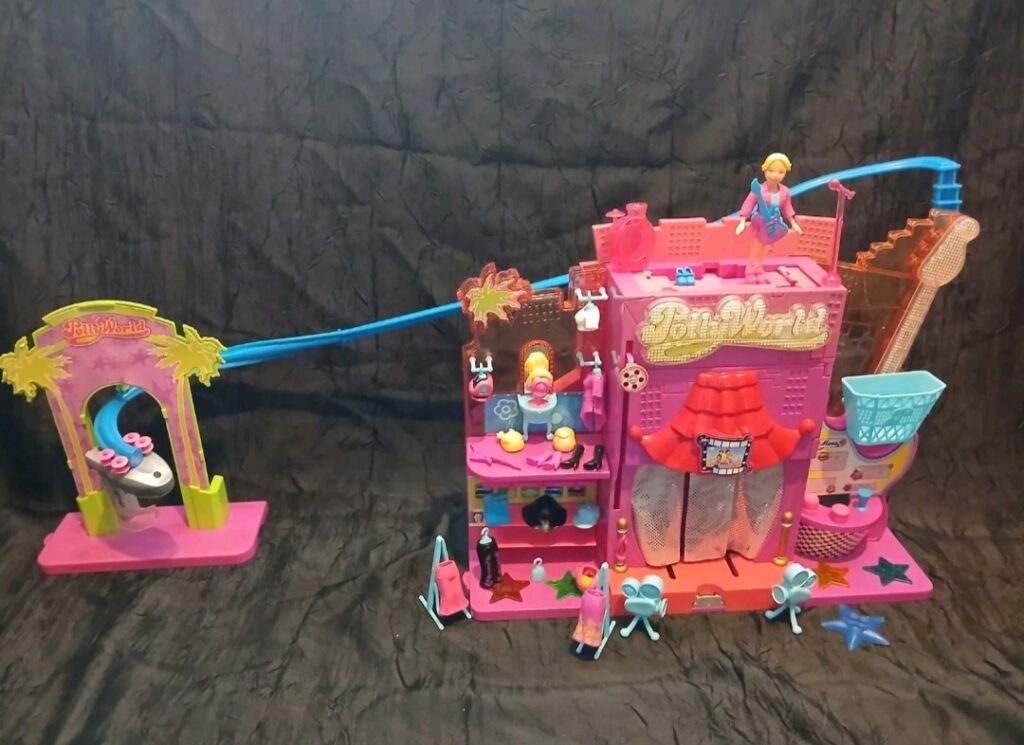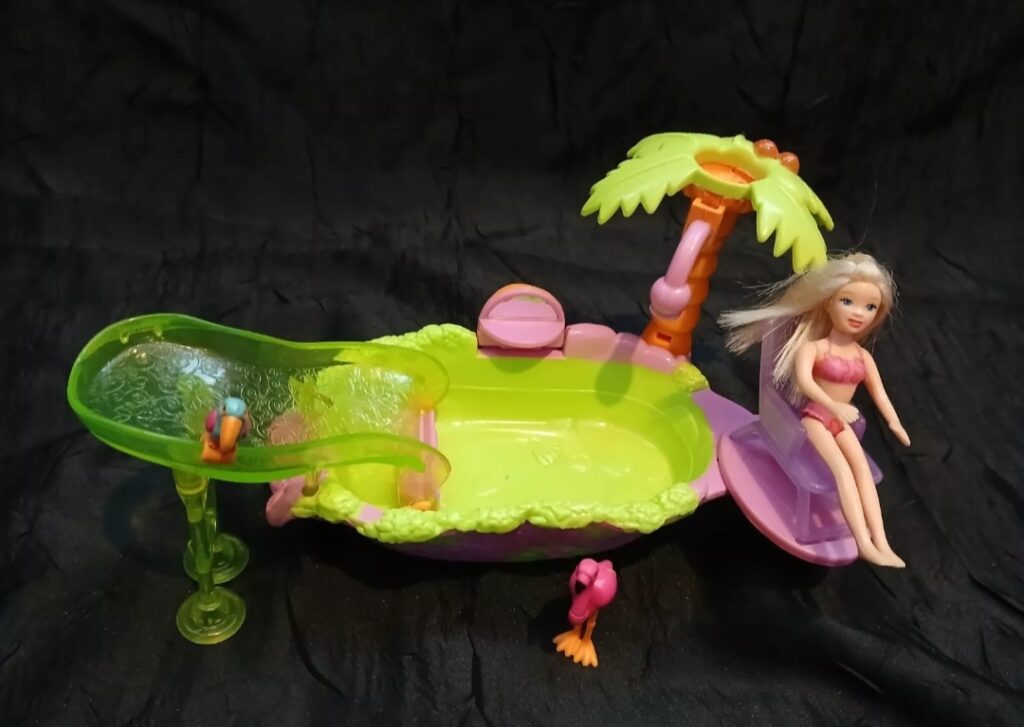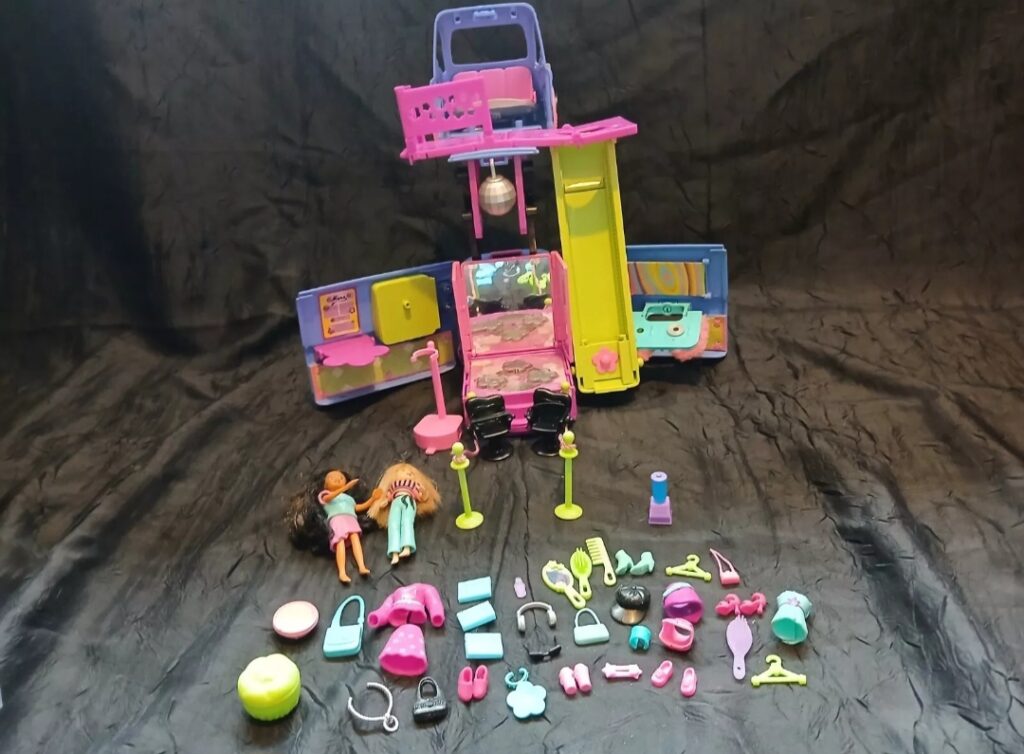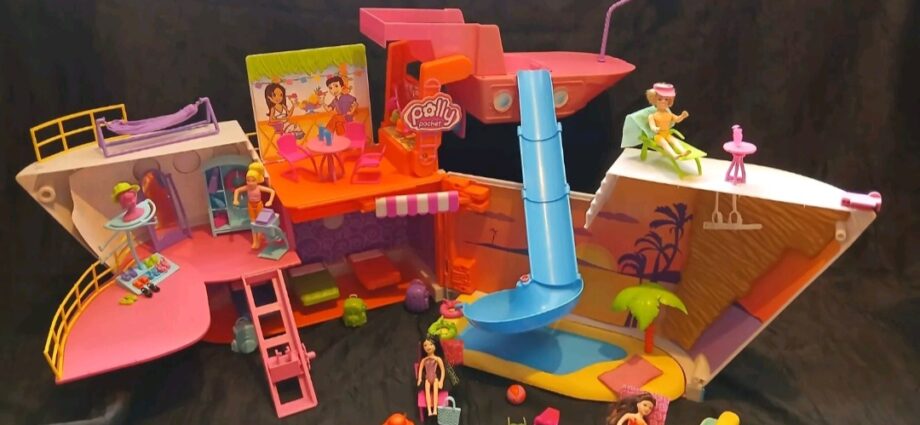The Birth of Polly Pocket (1989-2000)
Polly Pocket was born out of a clever design concept that aimed to merge portability with imaginative play. The idea came from Chris Wiggs in 1983, who created the original Polly Pocket as a compact, portable dollhouse. Wiggs, a British inventor, designed it for his daughter by repurposing a powder compact, placing a small figurine inside a tiny world that could easily be carried around. This small scale and portability would become Polly Pocket’s defining features.
In 1989, Bluebird Toys, a UK-based toy company, licensed the idea and launched Polly Pocket to the mass market. Each compact opened to reveal a colourful, detailed environment, complete with a miniature doll no taller than one inch. The compact themes ranged from tiny homes and castles to amusement parks and underwater worlds. The key innovation was the pocket-sized portability combined with intricate design. The small dolls had pegs to fit into holes within the compact, allowing them to “stand” and interact with their environments, adding another layer of playability.
Polly Pocket’s success was immediate, driven by the novelty of its tiny design, imaginative playsets, and affordable price point. It became a hit throughout the 1990s, particularly among young girls. The brand expanded its reach globally, especially in Europe and North America. Over time, Bluebird Toys developed hundreds of compact playsets, varying in size and complexity. The late 90s even saw the introduction of Polly’s friends, like Lulu, Lea, and Shani, increasing the brand’s diversity.
In 1998, however, Bluebird Toys faced financial difficulties, and Mattel, the giant American toy company, acquired the brand. Initially, Mattel continued producing the traditional Polly Pocket sets, but in 2000, they decided to revamp the entire line. This marked the end of the classic “tiny” Polly Pocket era.

The Evolution and Collectability of Polly Pocket (2000s-2010s)
With the acquisition by Mattel, Polly Pocket underwent a significant transformation. By 2002, the original tiny Polly Pocket concept had been replaced with a larger, more modern doll design, about three to four inches tall. These new dolls had more articulated limbs, interchangeable clothing, and accessories, making them more like fashion dolls, closer in style to Mattel’s iconic Barbie line. While this change opened Polly Pocket to new play possibilities, it also alienated some long-time fans who preferred the original compact format.
Despite this, Polly Pocket continued to thrive in the early 2000s, leveraging the fashion doll craze. The larger dolls allowed for more detailed accessories, and Polly’s world expanded into themes like fashion shows, summer adventures, and elaborate houses. TV shows, direct-to-DVD movies, and online games further cemented Polly’s place in pop culture, and her brand recognition remained high.
During this period, interest in the original Polly Pocket compacts from the 1990s grew among collectors. As the market shifted away from the original small dolls, those vintage sets became increasingly sought after by adults who had grown up with the toys. The rarity of certain playsets, especially limited edition or discontinued ones, added to their appeal.
Collectors appreciated the nostalgia, artistry, and engineering of the classic Bluebird sets, which had intricate details and clever mechanical features. Some of the most coveted playsets included the 1992 Polly Pocket Magical Mansion, Polly’s Vacation Fun, and the Polly Pocket Starlight Castle. The condition of these sets—whether they still included the original dolls, whether the paint and mechanisms were intact—also became crucial factors in determining their value.
Online selling sites saw a surge in Polly Pocket listings, with some rare and well-preserved sets selling for hundreds or even thousands of dollars. The rise of social media and online fan communities further fuelled interest in Polly Pocket as a collectible item, and YouTube channels dedicated to toy unboxings, reviews, and vintage Polly Pocket nostalgia sprang up, helping drive its status as a collectible brand.

The Modern Reboot of Polly Pocket (2018-Present)
In 2018, Mattel decided to reboot Polly Pocket, returning to the brand’s roots by reintroducing compact playsets and smaller dolls, much to the excitement of nostalgic fans and a new generation of children. The rebooted Polly Pocket, while honoring its classic design, came with modern updates, appealing both to long-time fans and newcomers.
The new sets were slightly larger than the originals but maintained the core idea of portable, miniature worlds. Each compact featured Polly in environments like tropical islands, castles, or theme parks, often with mechanical features such as elevators, trap doors, or hidden compartments. The dolls remained small but were given a softer, more detailed aesthetic with flexible rubbery clothing instead of hard plastic. This made them more durable and easier to play with, particularly for younger children.
Accompanying the relaunch, Polly Pocket received a new animated TV show that aired on streaming platforms like Netflix, which followed Polly and her friends as they embarked on adventures using a magical locket that allowed them to shrink to a tiny size. This series helped reintroduce Polly Pocket to a digital-native generation while emphasising the creativity and imagination that defined the original brand.
The new Polly Pocket line has been met with a generally positive reception, with both young children and collectors embracing the new sets. Mattel has capitalised on the nostalgia for the 1990s toys, releasing special anniversary editions and throwback designs to appeal to adult collectors. Limited-edition compacts, vintage-style packaging, and retro Polly Pocket merchandise have been marketed directly to collectors, some of whom are willing to pay high prices for sets that evoke their childhood memories.
This reboot has successfully navigated the delicate balance between maintaining the spirit of the original Polly Pocket while updating the design for modern play patterns. The inclusion of technological enhancements, like interactive lights and sounds in some compacts, has helped keep the brand fresh and competitive in a crowded toy market. Today, Polly Pocket continues to thrive, both as a playline for kids and a cherished collector’s item for adults who appreciate its blend of nostalgia and innovation.
In conclusion, Polly Pocket’s history reflects both the shifts in the toy industry and enduring trends in play. From its modest origins as a portable dollhouse concept, it grew into a beloved toy line, transcended generations through its collectability, and found renewed life in the modern era.

How Can Wildcard Curiosities Help
This blog is written in September 2024 and we currently have online for sale, the Polly Pocket Cruise Ship, Disco Bus, Polly World and Pool Set. All reasonably priced and in really good condition with the accessories. Take a look
